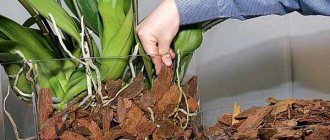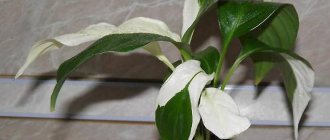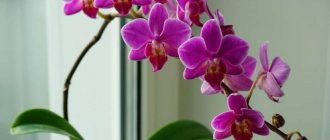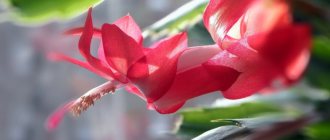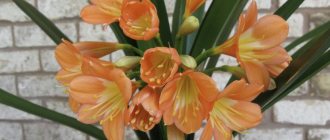When does flowering occur at home?
Different varieties of orchids begin to bloom at different ages . Usually the first buds appear when the flower is 1.5-3 years old. You can find out the age of an orchid by its shoots: if the plant is 2 years old or more, then there should be at least 5-8 of them.
Attention : Botany knows more than 30 thousand natural varieties of flowering orchids and the same number of artificially bred species of this plant.
After the orchid has bloomed and its peduncle has dried, you can wait for the next flowering no earlier than in 2-3 months. This fact is due to the fact that a healthy plant, with proper care, can generate flower stalks only 2-3 times a year , and the duration of flowering itself is usually about 3 months. However, not all orchids obey the general rules, and the reason for this is often the incorrect conditions of their maintenance and the owners’ ignorance of how to act correctly to achieve flowering.
Other diseases and pests
If an orchid is literally “fighting for life,” it will definitely not bloom. The list of diseases and pests typical of this plant is quite long. Therefore, you need to be able to identify the problem and know what to do in each specific case.
To notice the development of a disease or pest attack at an early stage, when it is easier to cope with the problem, it is recommended to inspect the plants once every 5-7 days.
Having discovered characteristic symptoms, the most severely affected parts of the plant are disposed of, if possible, then the “pet” is treated with a suitable chemical - a fungicide, insecticide, acaricide.
Orchids are deservedly considered delicate, capricious and demanding plants to care for. Their “fragility” and “vulnerability” requires the provision and maintenance of a specific microclimate and competent care. Otherwise, you may not expect flowering. It is also necessary to take into account the development cycle - buds will not appear at the “inopportune” time, despite all your efforts.
Why does it take so long for it to start?
There may be several reasons why an orchid is in no hurry to please its owner with flowers for more than a year, or even two.
Any type of orchid plant does not like moving in space. Even a pot turned the other side towards the light source becomes serious stress for them. As a result of rotating and rearranging the plant from place to place, delays in the appearance of the peduncle may occur, and the buds that have already formed may begin to fall off.- A common reason for an orchid not blooming may be that its root system is not getting enough light. It is the roots that ensure complete photosynthesis of the entire plant, so flowering orchids should be planted only in transparent pots.
- An orchid will never bloom if it doesn't have enough light. Therefore, for this plant to bloom, it is important to provide it with the proper level of light. On winter days, LED lamps will come to the rescue, helping to extend daylight hours for the required amount of time (as a rule, orchids require 10 hours of bright light for regular flowering).
- The absence of daily and seasonal temperature changes in the room also leads to a delay in the flowering of orchids. All that is needed in this case for flowering is to create conditions as close as possible to natural conditions for the plant, making sure that the air temperature at night is 4-6°C lower than during the day. An excellent solution would be to create an artificial winter for your green darling for at least 20 days at a temperature of 5-10°C above zero.
“Do’s” and “don’ts” during flowering
If you managed to make the orchids bloom or at least send out arrows, do not think that now you can just admire a tropical flower and do nothing. Be sure to follow our tips to ensure flowering lasts as long as possible:
- remove faded flowers in a timely manner,
- tie the arrows so they don’t break,
- provide long daylight hours.
It is also worth knowing what not to do with an orchid during the period of budding and flowering.
- You cannot move the pot from place to place . In nature, flowers always grow in the same place, so any movement is stressful for them. If you need to temporarily move the potty, try to return it to its place so that it is in its original position.
- You can't spray flowers . Drops of water remaining on flowers for a long time can cause stains to appear and buds to drop. In addition, drops from the leaves can flow into the axils or core of the rosette, causing rot. Use only a spray bottle that can produce so-called water mist, and spray the plant from afar.
- You cannot suddenly change the conditions of detention . When transporting from the store, especially in winter, the orchid experiences extreme stress. This may cause it to drop already formed buds or flowers.
- Do not place the pot next to a fruit basket or a fading bouquet . Ripe fruits emit ethylene, which promotes rapid ripening of buds and aging of flowers. Therefore, such a proximity can lead to the rapid fading of the orchid or the shedding of flowers and buds. A vase with a fading bouquet left nearby gives a similar result.
- Fertilizers cannot be applied . After the flower stalk appears, fertilizers are usually no longer applied. If they do this, then in accordance with the instructions, but not more than 2 times a week. However, after the first flower opens (or better before this moment), fertilizing should be stopped completely. Otherwise, it may interrupt flowering and force the plant to drop its buds.
Is it necessary to artificially stimulate the plant?
In order for a recently transplanted orchid to produce large and bright flowers, care should be taken to artificially stimulate its flowering . It is important to make sure that the plant is completely healthy, has strong roots and powerful and fleshy leaves.
- Most often, an orchid's flowering is stimulated by placing it in a stressful situation. If the plant has begun to become “lazy” and has not put out a flower stalk for a long time, you can try to push it to flower by watering. To do this, immerse the pot in water heated to 40-45°C and leave it there for 30 minutes.
- A hot shower is also a useful stimulator for orchid flowering. Place the plant in the bath and pour a very warm stream of water over its leaves and roots (the temperature should be tolerable for your hands, otherwise you can burn the roots and leaves!).
- If the orchid has never bloomed yet, despite the appropriate age, as well as the number and quality of shoots, you can try sending it to a cool balcony for a week or two (the room temperature should not fall below 0°C). This procedure will simulate the wintering of the plant under natural conditions, thereby bringing its flowering period closer. After you bring the flower back into the house, a peduncle will soon appear on it.
Natural habitat of an orchid
In answering this question, it is necessary, first, to consider the natural, natural growing conditions of the orchid.
Its natural habitat is tropical forest, covered with thick foliage of phalaenopsis (the Latin name for orchids). Based on the climate conditions and place of growth, it is practically indifferent to the change of season and the length of daylight hours.
You can also note the natural conditions in which the flower grows. The rainy season in tropical latitudes gives way to drought. Both periods can last a long time - up to several months. By adapting to climate changes, the orchid stimulates itself to bloom abundantly, which can last for several months.
It is no coincidence that we gave an example of the life of a flower in natural conditions. Having moved into our apartments, the tropical beauty continues to try to maintain the same habits that were instilled in her in her homeland. Of course, we are not able to maintain similar conditions of a tropical climate in a city apartment, but we are obliged to at least follow the “rules of the game”, according to which our, in principle, unpretentious guest will live in our conditions and delight with her marvelous blooms.
Why doesn’t it produce buds and grow leaves?
Most often, a stop in development and growth is associated with a lack of fertilizers. To stimulate active vegetation, you should treat the leaves of the plant with a special fertilizer for phalaenopsis. After the vegetative function is completely restored, the plant will increase the necessary green mass and, subject to proper maintenance, will delight the owner with a young peduncle.
Read about how to understand why an orchid does not bloom here.
If it produces only roots and leaves
If the orchid does not bloom but produces leaves, it may be in a dormant period . As a rule, the resting time of orchid plants lasts from 1.5 to 3 months, during which the plant should be provided with a cooler temperature regime.
If there is no flowering for more than three months, it is necessary to understand the watering regime, as well as the humidity and temperature in the room where the orchid is kept. It is necessary to adjust the housing conditions and create stressful conditions for the plant to successfully force the peduncle.
We recommend watching a video about the reasons for the lack of flowering of an orchid when growing leaves:
Orchid does not bloom - what to do
In tropical environments, orchids live under the cover of dense foliage, so for orchids there is no such thing as a change of season. The most unpretentious type of orchid is phalaenopsis, which can bloom continuously for 11 months. However, achieving this result at home is not so easy. For an orchid to bloom, create special conditions for it.
Sudden changes in temperature
During the daytime, the orchid should be in a warm room. At night, you can open a window or balcony if you want to lower the temperature to 16 – 18°C. In summer you can take the orchid into the garden. Being outside will speed up photosynthesis and promote the accumulation of carbon dioxide, which stimulates flowering.
Creating an arid desert environment
If the orchid does not bloom, but the leaves grow, then reduce the amount of watering. To create a dry climate, increase the time between waterings. In summer, water the orchid once every 4 days, in winter once a week. The orchid roots must be dry. If you water the plant correctly, the lower leaves will be a little soft.
Hot shower
Before starting this procedure, fill the bathroom with steam by turning on hot water. Pour warm water over pots with orchids for 15 minutes, temperature about 35°C. During this time, the plant absorbs moisture through the roots and intensively releases moisture through the leaves. After a week, the orchid should release flower stalks.
Improved lighting
Different types of orchids do not bloom after transplantation because they require different lighting intensities. When a plant does not bloom for a long time, it may not be receiving enough light. Move the orchid pot to another more illuminated place or buy a special fluorescent lamp.
Pruning the peduncle
On each peduncle there are several buds that are in a dormant state. In order to stimulate flowering, cut the arrow to about 3 buds.
If the peduncle is completely dry, it is removed. The living peduncle of phalaenopsis is not cut off after flowering, since it is on it that the buds are located, from which new arrows will appear.
At the same time, trimming the peduncle is a good way to make a phalaenopsis orchid bloom at home a second time. After flowering, the phalaenopsis is cut off the peduncle two centimeters above the dormant bud from which it would be desirable to get a new arrow. The closer the peduncle is cut to the rosette, the more abundant the next flowering will be.
Transfer
Lack of flowering can sometimes be due to soil depletion. This is always visible from the leaves of the plant. When the growing leaves are smaller in size than the old ones, or they are of a different shape, it means that the orchid needs to be transplanted into a new substrate.
There are orchids that produce a flower stalk only after reaching three years of age. The plant is mature enough and is ready to flower only when it already has 5–8 shoots. Flowering can only be stimulated in healthy orchids. To release a flower branch, wilted and diseased orchids must gain strength.
How to make it produce buds by changing watering?
Watering regime is especially important for the successful flowering of an orchid . How to speed up flowering by changing watering? Water the plant by completely immersing the pot in water. In order for the dry substrate to be sufficiently saturated with moisture, it is necessary to remove the flowerpot from the decorative flowerpot and lower it into water for 3-5 minutes. After watering, the plant should be pulled out, excess water should be allowed to drain from the pot and put back in its original place.
Such manipulations should be performed once every two weeks in winter and once every 10 days in summer. More frequent bathing can lead to rotting of the root system and disease, and sometimes even complete death of the plant.
Orchids gravitate to the humid climate of the subtropics, so it is important to maintain high humidity in the room where they are grown. The plant should be sprayed daily using well-settled warm and soft water.
The orchid has stopped blooming: problems and ways to solve them
If you properly care for your orchid, it will bloom for a very long time.
Table: tips on how to make an orchid bloom twice a year
| Description of the problem | Cause | Solution |
| The orchid only grows large leaves and roots. | Growing season, excessive fertilizing with nitrogen | After winter, the plant increases its green mass and the orchid will bloom only at the end of the growing season. Water the flower with fertilizers with a predominance of potassium and phosphorus. |
| Orchid does not bloom after transplantation | The plant regains strength and grows roots | For better survival after transplantation, pour Epin or succinic acid - this will strengthen the orchid and help awaken dormant buds. |
| The orchid has sent out an arrow, but does not bloom | Individual characteristics of an orchid | An orchid can form buds, but not bloom them for up to three months. Try feeding with fertilizer diluted by half. |
| The orchid does not bloom for more than a year | Improper care | Lack of light, regular frequent watering, and the same day and night temperatures lead to the fact that the orchid grows but does not bloom. Stress the plant:
|
| The orchid's buds are falling off |
|
|
How to stimulate by adjusting the length of daylight hours?
Tip : The reason for the orchid’s reluctance to bloom may lie in the lack of light. Care must be taken to ensure that the plant is illuminated for at least 10-12 hours a day. To ensure this condition, a phytolamp of a suitable spectrum that does not dry out the air is quite suitable.
Despite the light-loving nature of orchids, you should not place them on south-facing windows in the summer : there they can get sun and temperature burns. In addition, any plant needs a night rest phase for the photosynthesis process to properly occur, so do not forget the plant under the included phytolamp at night.
How to care for an orchid after flowering
The period when plants bloom lasts from 5 to 12 months. After the flowers dry, do not immediately cut off the peduncle. You should make sure that the orchid has stopped blooming. The arrow is carefully examined to determine further actions. If there is a green tip, additional buds may appear.
If the peduncle turns yellow and begins to dry out, flowering has ended. But the plant continues to receive nutrients from the flower branch. Therefore, the arrow is cut after complete drying.
The cut is usually made, leaving the 3 lower buds; the stump should be at least 2 cm. In the summer, a young shoot - a baby - may appear on the flower branch. With its help, the plant is propagated. To do this, the baby is left on the stem for about 6 months, until roots and 2 leaves grow. Phalaenopsis can develop 2–3 offspring on each peduncle.
Otherwise, caring for the plant after flowering does not differ much from other periods. During dormancy, you can reduce the amount of feeding to once a month. If the soil dries out quickly after watering, and roots protrude from the bottom hole of the pot, the orchid needs to be replanted. The period immediately after flowering is the most suitable for this procedure.
Before transplanting, water the plant abundantly and carefully remove it from the pot. The roots should not be unrolled. Blackened and dried shoots are removed. The soil mixture can be pre-heated over a fire to kill pests. To create drainage, a layer of crushed granite stone is placed on the bottom of the pot. The orchid is placed in the new soil at the same level as before. After transplantation, watering is not needed. Spraying can be done.

